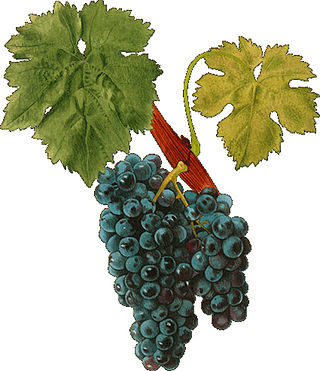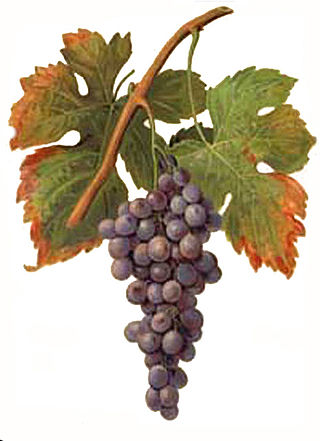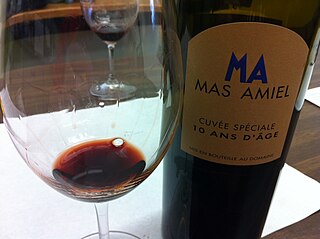
Rioja is a wine region in Spain, with denominación de origen calificada. Rioja wine is made from grapes grown in the autonomous communities of La Rioja and Navarre, and the Basque province of Álava. Rioja is further subdivided into three zones: Rioja Alta, Rioja Oriental and Rioja Alavesa. Many wines have traditionally blended fruit from all three regions, though there is a slow growth in single-zone wines.

Carignan is a red grape variety of Spanish origin that is more commonly found in French wine but is widely planted throughout the western Mediterranean and around the globe. Along with Aramon, it was considered one of the main grapes responsible for France's wine lake and was a substantial producer in jug wine production in California's Central Valley but in recent years, it has been reborn as a flagship wine for many cellars in the south of France as well as in Catalonia.

Grenache or Garnacha is one of the most widely planted red wine grape varieties in the world. It ripens late, so it needs hot, dry conditions such as those found in Spain, where the grape is believed to have originated. It is also grown in the Italian island of Sardinia, the south of France, Australia, and California's Monterey AVA, Paso Robles, Santa Barbara County and San Joaquin Valley.

Palomino Fino is a white grape widely grown in Spain and South Africa, and best known for its use in the manufacture of sherry. It is also grown in the Douro region of Portugal where it is used for table and fortified wines.

Maury is an Appellation d'Origine Contrôlée (AOC) for fortified vin doux naturel wines made in the Roussillon wine region of France. Almost all wines are red, made from at least 75% Grenache noir (Garnacha). Other permitted grapes are Grenache blanc, Grenache gris, Macabeu (Macabeo), Malvoisie du Roussillon (Tourbat), Syrah, Muscat and other local varieties. Although the grapes are different, they are used and marketed very much like port. It is made in the communes of Maury, Saint-Paul-de-Fenouillet, Lesquerde, Tautavel and Rasiguères. The AOC was granted in 1936.

Parellada is a Spanish white grape variety of Catalan origin specially grown in Catalonia, Spain. With Macabeu and Xarel·lo, it is one of the three traditional varieties used to make the sparkling wine Cava, which is primarily produced in Catalonia. Besides its use in Cava, it is used mostly for blending in young white wines, although some more ambitious oaked blends with Chardonnay and Sauvignon blanc are also used. Spanish plantations stood at 10,000 hectares in 2004,

Spanish wine includes red, white, and sparkling wines produced throughout the country. Located on the Iberian Peninsula, Spain has over 1.2 million hectares planted in wine grapes, making it the most widely planted wine-producing nation, but the second largest producer of wine in the world, behind Italy and ahead of France and the United States. This is due, in part, to the very low yields and wide spacing of the old vines planted on the dry soils found in some of the Spanish wine regions. The country is ninth in worldwide consumption with Spaniards drinking, on average, 21.6 litres per person a year. The country has an abundance of native grape varieties, with over 400 varieties planted throughout Spain, though 88 percent of the country's wine production is from only 20 grapes — including the reds Tempranillo, Bobal, Garnacha, and Monastrell; the whites Albariño, Airén, Verdejo, Palomino, and Macabeo; and the three Cava grapes Parellada, Xarel·lo, and Macabeo.

Grenache blanc is a variety of white wine grape that is related to the red grape Grenache. It is mostly found in Rhône wine blends and in northeast Spain. Its wines are characterized by high alcohol and low acidity, with citrus and or herbaceous notes. Its vigor can lead to overproduction and flabbiness. However, if yields are controlled, it can contribute flavor and length to blends, particularly with Roussanne. Since the 1980s, it has been the fifth most widely planted white wine grape in France after Ugni blanc, Chardonnay, Semillon and Sauvignon blanc.

Cariñena is a Spanish Denominación de Origen Protegida (DOP) for wines located in Cariñena in the province of Zaragoza. It is among the oldest protected growing areas in Europe, the DO having been created in 1932 alongside other Spanish wine regions. Cariñena vineyards are located near the centre of Aragón, about 50 km southwest of Zaragoza, on the Campo de Cariñena plateau. The lower vineyards lie at an altitude of 400 m, rising to 800 m as they approach the Sierra de la Virgen mountains. To the west they border on the Calatayud (DO).

Alella is a Spanish Denominación de Origen (DO) for wines produced in Maresme county in the province of Barcelona in the Spanish autonomous communities of Catalonia, located on the Mediterranean coast, 15 km to the north of the city of Barcelona.

Xarel·lo is a white grape variety of Spanish origin specially grown in Catalonia.

Priorat is a Denominació d'Origen Qualificada (DOQ) for Catalan wines produced in the Priorat county, in the province of Tarragona, in the southwest of Catalonia.

Ribera del Guadiana is a Spanish Denominación de Origen Protegida (DOP) for wines located in the region of Extremadura (Spain). It extends over two provinces, Cáceres in the north and Badajoz in the south. It takes its name from the River Guadiana, which flows through the region from east to west.

Catalan wines are those that are produced in the wine regions of Catalonia. Occasionally, the appellation is applied to some French wine made in the Catalan region of Roussillon and neighboring areas, also known as Northern Catalonia or the Pays catalans. The city of Barcelona is the capital of Catalonia and despite not being in a wine region, it is the focal point of the Catalan wine industry: a primary consumer market, its port provides export functions and a source of financial resources and investment. The Penedès is the largest wine-making region in Catalonia.

Penedès is a Spanish Denominación de Origen Protegida (DOP) for wines in Catalonia, (Spain). Penedès DOP includes all of the Penedès region and municipalities of four other counties: Anoia, Alt Camp, Baix Llobregat and Tarragonès. The area is framed by the coastal hills of the Garraf Massif and the higher inland mountains which skirt the Central Depression.
Cava is a sparkling wine of Denominación de Origen (DO) status from Spain. It may be white (blanco) or rosé (rosado). The Macabeo, Parellada and Xarel·lo are the most popular and traditional grape varieties for producing cava. Chardonnay and Malvasia are also permitted. Authorized red grapes are Garnacha tinta, Monastrell, Trepat, and Pinot Noir. Only wines produced in the traditional method may be labelled "cava"; those produced by other processes may only be called "sparkling wines". About 95% of all cava is produced in the Penedès area in Catalonia, Spain, with the village of Sant Sadurní d'Anoia being home to many of the largest Catalan production houses. The two major producers are Codorníu and Freixenet. Cava is also produced in other villages in the provinces of Girona, Lleida, Tarragona, and Barcelona in Catalonia, Zaragoza in Aragon, Badajoz in Extremadura, La Rioja, Araba/Álava in the Basque Country, Navarra and València in the Valencian Community.

Tempranillo blanco is a white Spanish wine grape variety that is grown in the Rioja Denominación de Origen (DOC). It is a mutation of the red Tempranillo grape variety that is planted in Rioja. The white grape variety was discovered in a Tempranillo vineyard in the Rioja region by a wine grower in the late 20th century. In 2007, the Consejo Regulador of Rioja officially sanctioned the use of Tempranillo blanco in the DOC wines of Rioja.

Treixadura or Trajadura is white Portuguese wine grape variety grown primarily in the Vinho Verde wine region of northeast Portugal and the Galician wine regions of Ribeiro and Rías Baixas in Spain where the variety is known as Treixadura. The grape is primarily a blending variety that adds body and light lemony aromatics to wines. It is most commonly blended with Loureiro and Alvarinho in Rías Baixas while in Ribeiro it is often blended with Torrontés and Lado.
Forcallat tinta is a red Spanish wine grape variety that is native to the Castile-La Mancha region of central Spain, as well as in Alicante and Valencia provinces in the Valencian Community. The name of the cultivar means "forked" in Valencian, which probably refers to the bunches having a wing or shoulder, rather than a tendency to produce forked vines as suggested by Favà. It tends to produce pale-colored wines and is most often used as a minor blending component in Vino de la Tierra (VdlT) wines. It is an authorized variety in the Comunitat Valenciana, where it has become almost extinct and only a few wine makers like Rafael Cambra are making efforts to recover it, with interesting proposals like La forcallà d'Antònia. Extant plots are found in Fontanars dels Alforins, La Font de la Figuera, Villena and probably Moixent, though the cultivar was once a prevailing one in La Vall d'Albaida and Alto Vinalopó regions. Bodega la Encina in Villena (Alicante) with vineyards in neighbouring Almansa (Albacete) also works with the variety, offering wines from biodynamic and organic farming. DNA profiling conducted in the early 21st century determined that the white berried Forcallat blanca grape is a distinct variety and not a color mutation of Forcallat tinta. The white cultivar Trepadell is also called Forcallat blanc in the village of La Font de la Figuera, with only one remaining plot of about 600 plants. Trepadell is also present in the Marina Alta region and has been elaborated by Curii uvas & vinos.
IGP Murcia is a Spanish geographical indication for Vino de la Tierra wines located in the autonomous region of Murcia. Vino de la Tierra is one step below the mainstream Denominación de Origen indication on the Spanish wine quality ladder, and mirrors the Vins de pays of French wine. It acquired its Vino de la Tierra status in 2011.


















